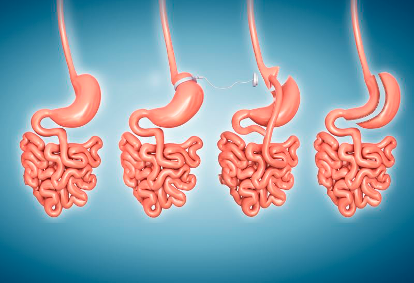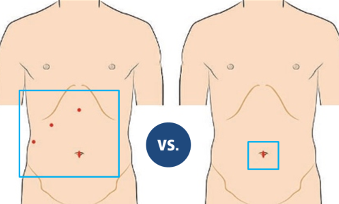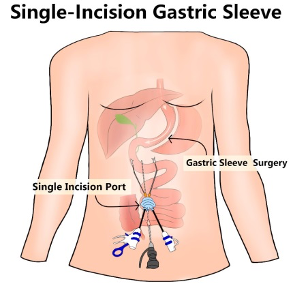What is Weight Loss & Metabolic Surgery ?
When Diet and Exercise give no result , the best way to get rid of your over-weight is surgery. Metabolic surgery is the most effective and long-lasting treatment for obesity.
Weight loss & Metabolic surgery works by changing the anatomy (or position) of the stomach and small intestines. This causes changes in appetite, satiety (feeling full), and metabolism (how the body burns calories).
Many of the hormonal signals that cause weight gain or inability to lose weight are affected by these procedures, and it becomes easier to lose weight. But this still requires a healthy diet and a good exercise routine. These procedures are tools to treat a chronic disease, and cannot work alone.

What can Weight Loss & Metabolic Surgery do ?
Surgery results in significant weight loss and leads to the improvement, prevention or resolution of many related diseases including type 2 diabetes, heart disease, hypertension, sleep apnea, and certain cancers.
Studies show metabolic surgery may reduce a patient’s risk of premature death by 30-50%. Patients typically lose the most weight one-to-two years after bariatric surgery, and maintain substantial weight loss with improvements in obesity-related conditions.
Weight Loss & Metabolic Surgery Process
You’ll be sedated for the procedure with general Anesthesia
The process is different from surgery to another :
Gastric Sleeve
Gastric sleeve surgery is almost always done as a minimally invasive procedure using a laparoscope. This means a long, thin tube is inserted into your abdomen through several small incisions. This tube has a light and a tiny camera attached to it as well as various instruments.
The surgery entails dividing your stomach into two unequal parts. About 80 percent of the outer curved part of your stomach is cut away and removed.
The edges of the remaining 20 percent are then stapled or sutured together. This creates a banana-shaped stomach that’s only about 25 percent of its original size.
The small incisions in your abdomen typically heal quickly. The minimally invasive nature of the surgery helps you recover faster than a procedure where your abdomen is opened with a larger incision.



Can everyone have a Weight Loss & Metabolic Surgery ?
You are requested to be over 18 and free of any cardiovascular diseases to be operated by this procedure.
In general, Weight Loss & Metabolic Surgery could be an option for you if:
· Efforts to lose weight with diet and exercise have been unsuccessful
·you have a serious weight-related health problem, such as type 2 diabetes, high blood pressure or severe sleep apnea
However, although this surgery is a weight loss procedure, an overweight patient with a BMI range in between 30-35 and no medical condition such as any vitamin deficiency and Diabetes should consider Gastric sleeve surgery instead of Gastric Transit Bipartition surgery as a first option. Your surgeon will choose which surgery is the best fit for you.
Meanwhile, having a BMI value over 45 qualifies the patient for Transit Bipartition surgery even though the patient may not have diabetes or any vitamin deficiencies.
Instructions for better Weight Loss & Metabolic Surgery
The following instructions are general information to be followed before and after a Weight Loss & Metabolic Surgery procedure:
Pre-Operation:
·Beginning 1 week before surgery, do not take any aspirin, or any other type of blood thinners, herbal medication or NSAIDS (Motrin or ibuprofen, Aleve, or Naprosyn, Celebrex or Celecoxib, Mobic or Meloxicam, etc.). Tylenol or Tylenol Arthritis 650 mg every 4 hours as needed is safe.
·DO NOT SMOKE!!! You must stop smoking and cannot start smoking after surgery. Smoking decreases your healing process.
·Continue your EXERCISE program. This will help you and your recovery after surgery.
·Start your Liquid Diet 2 Weeks Prior to Surgery: You need to have 60-70 grams of protein per day and less than 800 calories. DON’T start your liquid diet until a surgery date has been arranged with surgeon.
·Eliminate from your diet: All fats, butter, fatty meats, fried foods, whole milk products/ High sugar foods/ carbonated drinks/ High carbohydrate foods, such as, breads and starches/ Bananas- they are high in sugar
·Purchase protein shake: Protein drinks can be mixed with water or skim milk. While on the two week liquid diet you may also consume clear liquids
·On the morning of the Day Before surgery, begin a clear liquid diet. This will help make the stomach and intestines easier to handle during the operation.
·Drink a 10-12 oz bottle of Magnesium Citrate
·On the Night before surgery, take a long shower or bath and clean your abdomen 3 to 4 times with soap and water. Pay special attention to cleaning your belly button area
·Do not eat or drink anything after midnight on the evening before surgery.
Post-Operation:
On the day of your surgery, you will not be allowed to eat or drink anything. The first day after surgery, an Upper GI series test will be performed to evaluate your new stomach and check for leaks-if there are no leaks, you will be cleared to start the STAGE ONE DIET. This diet consists of WATER ONLY. You should drink 1 oz. of water every hour while you are awake, you need to drink water that is at room temperature, sip slowly and avoid straws.
If you tolerated the Stage one diet, you will be advanced to the Stage Two Diet the next day (the second day after surgery). The Stage Two Diet is High Protein Liquid Diet. You will drink 2 oz. (1/4 cup) of a high protein fluid every hour while you are awake. In addition, you should drink 1 oz. of an appropriate clear liquid (no calories, carbonation) every 15 minutes while you are awake.
Your primary goal is to stay hydrated, so you need to drink 64 oz. of fluid daily (no caffeine, carbonation, or alcohol). Your next goal is to consume 60-70 grams of protein per day.
3 weeks after surgery to 3 months you can begin eating soft foods now; however, you need to change your eating habits to avoid pain and vomiting, rupture of the staple lines and to aid in weight loss. At this time, the tissue around the staples and sutures in the stomach are very swollen and needs to heal. All foods need to be “fork tender” or softer. Always eat high protein foods first; you may eat carbohydrate foods if you have room after eating protein.
Examples of high fiber foods to avoid: nuts, fruit and vegetable skins and salad greens.
Examples of high fiber food to limit: whole grain bread, whole wheat pasta, brown/wild rice, beans, and bran cereal.
Look for foods with no more than 2-3 grams of fiber/serving. You will be encouraged to increase your fiber intake at your 3 month appointment when your diet is advanced to regular/high protein. You should also avoid foods that are high in fat and/or high sugar. Look for foods with no more than 5 grams of fat/serving.
Eating techniques and goals
·Try 1 new food at a time and monitor your tolerance of that food.
·Limit your food volume to ½ cup (4 oz.)
·Take 20-30 minutes to eat every meal; take small bites and chew each bite 20-30 times. A small bite is the size of a dime. Even this dime-sized needs to be chewed 20-30 times, until it is the consistency of applesauce.
·To help you take small bites and control portions, you may want to use a saucer instead of a plate. Pay attention to taste; learn how to savor your food.
·Most importantly, SLOW DOWN. If you eat too fast, you do not give your stomach time to signal your brain that you are no longer hungry. This will cause you to eat too much, not lose your maximum potential weight and you may get sick.
·Eat only at meal times and snack times; do not graze on foods throughout the day. “GRAZING” on small amounts of food throughout the day will sabotage your weight loss and result in the inability to lose an adequate amount of weight. A healthy snack is appropriate if your meals are more than 4-5 hours apart.
·Stop eating as soon as you feel satisfied. Overeating even one bite can make you vomit and can lead to stretching of the stomach.
·Never drink more than 4 oz. of liquids with a meal. More fluid than this can push foods through the stomach faster, enabling you to eat more.
·Goals: you should get 64 oz of fluid per day and 40-60 grams of protein per day and a minimum of 30 minutes of exercise 3 times per week.
·At 3 months, you will be ready to progress from soft foods to regular consistency foods.
Average Length of Stay 3-10 Days
Length of Stay in Hospital 0-4 Days
Operation Duration 1-6 Hours
Anesthesia General Anesthesia
Recovery Duration 3 days -2 Weeks
FAQs
You may feel pain at your incision site or from the position your body was in during surgery. Some patients also experience neck and shoulder pain after laparoscopic bariatric surgery.
To be eligible for bariatric surgery, you must be between 16 and 70 years of age (with some exceptions) and morbidly obese and having a BMI over 30.
You can improve regularity by eating raw fiber vegetable every day. Starting about three weeks after weight loss surgery, you may increase your intake of vegetables, and beans to improve regularity. Drinking plenty of water may be the most important thing you can do for constipation.
Within a few weeks, you should start to feel less tired and get back into your normal routine. However, your stomach will still be healing. On average, it takes about 2-3 weeks for the incisions to heal and 6-8 weeks for the stomach staple line to heal
The stomach is built to stretch when food enters. When the stomach reaches capacity, it alerts your body that it’s full so you will stop eating. When a person overeats, the stomach stretches even more to accommodate the extra food. If this is a rare occurrence, the stomach will simply shrink back to the previous size
During the first month, patients can expect an average weight loss of up to 30 pounds. After three months, the percentage of overall excess loss can reach up to 30 percent. That number increases to 50 percent after six months – which means the expected weight loss translates to about two pounds per week
The three known types of surgery included gastric bypass, sleeve gastrectomy and adjustable gastric banding (also known as lap band). The study found that gastric bypass surgery boasted the greatest weight loss — both short- and long-term.
Most gastric bypass surgery is laparoscopic, which means the surgeon makes small cuts. That makes for shorter recovery time. Most people stay in the hospital for 2 to 3 days, and get back to normal activities in 3 to 5 weeks.
When you begin your gastric sleeve diet right after the procedure, you’ll be on liquids only. But most patients can still begin learning what signals to pay attention to. That “tight” feeling when you swallow? That means you’re full
